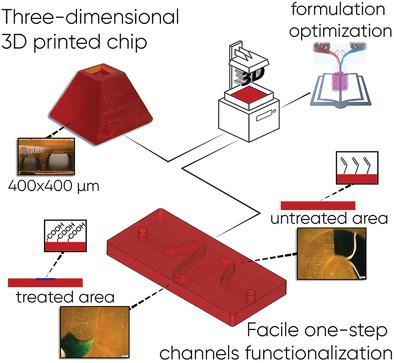当前位置:
X-MOL 学术
›
Adv. Mater. Technol.
›
论文详情
Our official English website, www.x-mol.net, welcomes your
feedback! (Note: you will need to create a separate account there.)
Fabrication and Functionalization of 3D Printed Polydimethylsiloxane‐Based Microfluidic Devices Obtained through Digital Light Processing
Advanced Materials Technologies ( IF 6.4 ) Pub Date : 2020-07-29 , DOI: 10.1002/admt.202000374 Gustavo Gonzalez 1, 2 , Annalisa Chiappone 1, 3 , Kurt Dietliker 4 , Candido Fabrizio Pirri 1, 2, 3 , Ignazio Roppolo 1, 3
Advanced Materials Technologies ( IF 6.4 ) Pub Date : 2020-07-29 , DOI: 10.1002/admt.202000374 Gustavo Gonzalez 1, 2 , Annalisa Chiappone 1, 3 , Kurt Dietliker 4 , Candido Fabrizio Pirri 1, 2, 3 , Ignazio Roppolo 1, 3
Affiliation

|
This work reports the preparation and 3D printing of a custom‐made photopolymer based on acrylate‐polydimethylsiloxane (PDMS), for the fabrication of complex‐shaped 3D printed microfluidic chips. By selecting and combining the proper materials during the preparation of the resins along with the freedom of design of light‐based 3D printers, 3D microfluidic PDMS‐like chips are obtained with excellent optical features, high chemical stability, and good mechanical properties. Furthermore, taking advantage of unreacted functional groups exposed on the sample's surface after the 3D printing step, the surface properties of the devices are easily and selectively modified during the postcuring step through UV‐induced grafting polymerization techniques, giving an added value to the printed devices in terms of surface treatment compared to conventional methods. The 3D printing of the PDMS‐based resins developed here may potentially transforms the fabrication methodology of PDMS microfluidic devices by decreasing manufacturing costs and time, allowing the production of complex‐shaped and truly 3D microdevices.
中文翻译:

通过数字光处理获得的基于3D打印的聚二甲基硅氧烷基微流体器件的制造和功能化
这项工作报告了基于丙烯酸酯-聚二甲基硅氧烷(PDMS)的定制光敏聚合物的制备和3D打印,用于制造复杂形状的3D打印微流体芯片。通过在树脂制备过程中选择和组合适当的材料,以及自由设计基于光的3D打印机,可以得到具有出色光学特性,高化学稳定性和良好机械性能的3D微流体PDMS类芯片。此外,利用3D打印步骤后暴露于样品表面的未反应官能团,可在后固化步骤中通过UV诱导的接枝聚合技术轻松,选择性地修饰设备的表面特性,与传统方法相比,在表面处理方面为印刷设备增加了价值。此处开发的基于PDMS的树脂的3D打印可以通过降低制造成本和时间来潜在地改变PDMS微流体设备的制造方法,从而允许生产复杂形状的真正3D微型设备。
更新日期:2020-09-10
中文翻译:

通过数字光处理获得的基于3D打印的聚二甲基硅氧烷基微流体器件的制造和功能化
这项工作报告了基于丙烯酸酯-聚二甲基硅氧烷(PDMS)的定制光敏聚合物的制备和3D打印,用于制造复杂形状的3D打印微流体芯片。通过在树脂制备过程中选择和组合适当的材料,以及自由设计基于光的3D打印机,可以得到具有出色光学特性,高化学稳定性和良好机械性能的3D微流体PDMS类芯片。此外,利用3D打印步骤后暴露于样品表面的未反应官能团,可在后固化步骤中通过UV诱导的接枝聚合技术轻松,选择性地修饰设备的表面特性,与传统方法相比,在表面处理方面为印刷设备增加了价值。此处开发的基于PDMS的树脂的3D打印可以通过降低制造成本和时间来潜在地改变PDMS微流体设备的制造方法,从而允许生产复杂形状的真正3D微型设备。











































 京公网安备 11010802027423号
京公网安备 11010802027423号